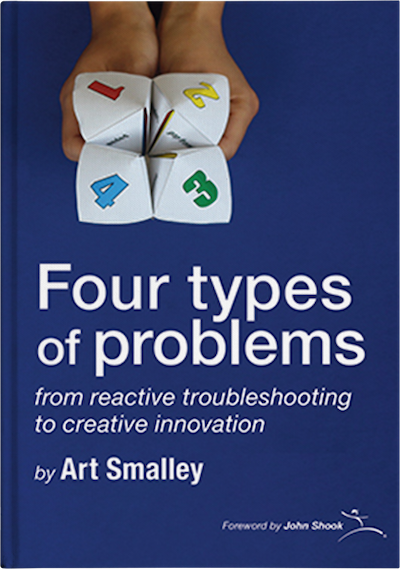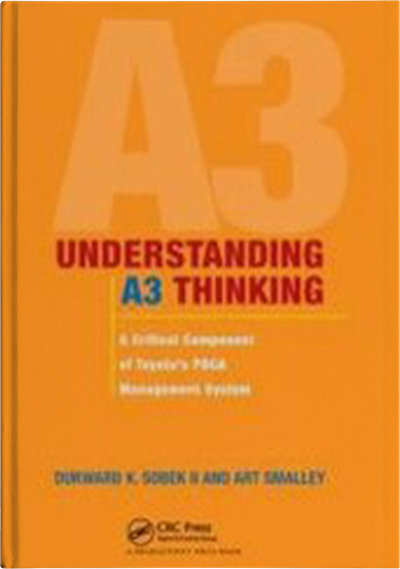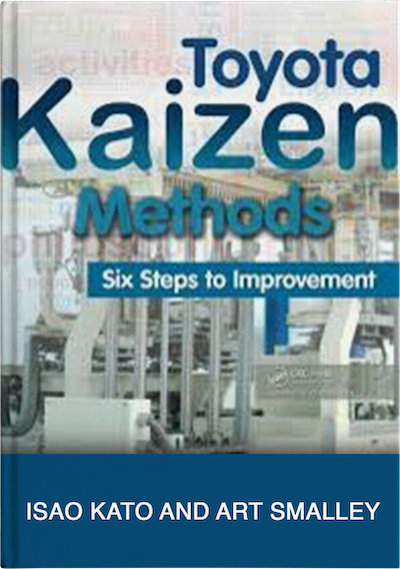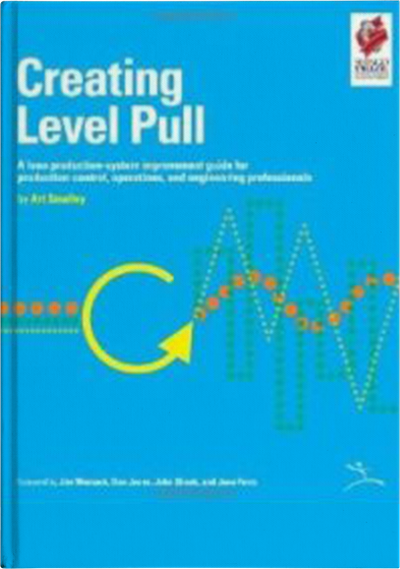Publications
World renowned Art Smalley has helped thousands of people in all types of organizations. Access 30+ years of experience with these 4 books.

Four Types of Problems
When faced with problems many business leaders and teams reach for familiar and standard problem-solving methods, often creating unnecessary struggle, frustration, delay, and ineffectiveness in solving the problem -- if it is ever solved at all! In other words, they keep reaching for the same old hammer as if every business problem were a nail.
In Four Types of Problems, continuous improvement expert and author Art Smalley shows you how to break the “hammer-and-nail” trap. He demonstrates that most business problems fall into four main categories: Troubleshooting, Gap-from-standard, Target-state, and Open-ended & Innovation.
Purchase On Amazon
Understanding A3 Thinking
Winner of a 2009 Shingo Research and Professional Publication Prize.
Notably flexible and brief, the A3 report has proven to be a key tool In Toyota’s successful move toward organizational efficiency, effectiveness, and improvement, especially within its engineering and R&D organizations. The power of the A3 report, however, derives not from the report itself, but rather from the development of the culture and mindset required for the implementation of the A3 system.
In Understanding A3 Thinking, the authors first show that the A3 report is an effective tool when it is implemented in conjunction with a PDCA-based management philosophy. Toyota views A3 Reports as just one piece in their PDCA management approach. Second, the authors show that the process leading to the development and management of A3 reports is at least as important as the reports themselves, because of the deep learning and professional development that occurs in the process. And finally, the authors provide a number of examples as well as some very practical advice on how to write and review A3 reports.
Purchase On Amazon
Toyota Kaizen Methods
Toyota Kaizen Methods: Six Steps to Improvement focuses on the skills and techniques practiced inside Toyota Motor Corporation during the past decades. This workbook focuses on the actual training course concepts and methods used by Toyota to develop employee skill level, a core element of Toyota’s success.
It is not a book about holding Western-style five-day Kaizen events, which were in reality quite rare during the development of Toyota’s production system and are virtually nonexistent today inside Toyota. Written by two of Toyota’s most revered and experienced trainers, the book ―
- Traces the origins of Kaizen since the inception of Toyota Motor Corporation
- Articulates the basic six-step Kaizen improvement skills pattern taught inside Toyota
- Helps practitioners of Kaizen improve their own skill level and confidence by simplifying concepts and removing any mystery in the process
- Provides homework assignments and a wealth of forms for analyzing work processes
If you take the time to study the concepts detailed here, you will be reviewing the same methods and techniques that were harnessed by generations of Toyota supervisors, managers, and engineers. These techniques are not the secret ingredient of Lean manufacturing; however, mastery of these timeless techniques will improve your ability to conduct improvement in almost any setting and generate improvement results for your organization.
Purchase On Amazon
Creating Level Pull
Creating Level Pull shows you how to advance a lean manufacturing transformation from a focus on isolated improvements to improving the entire plant-wide production system by implementing a lean production control system.
Lean efforts at most companies focus on point kaizen (e.g., reducing set up times, implementing 5S, etc.) that improves a small portion of the value stream running from raw materials to finished products. Or they focus on flow kaizen that improves the entire value stream for one product family. Creating Level Pull shows how companies can make the leap to system kaizen by introducing a lean production control system that ties together the flows of information and materials supporting every product family in a facility. With this system in place, each production activity requests precisely the materials it needs from the previous activity, and demand from the customer is leveled to smooth production activities throughout the plant.
Creating Level Pull is written in plain English and walks you through the implementation process using a clear question-and-answer format, supported by diagrams, value-stream maps, and key formulas. Using a realistic example facility, the author shows you how to make the transition to a robust pull system. This involves answering a series of 12 critical questions including what items to hold in finished goods inventory and what items to make to order, how to buffer the system against instability, how to schedule batch processes, and how to level the production schedule. Careful attention to leveling (called heijunka) permits facilities to accommodate variations in demand with minimum inventories, capital costs, manpower, and production lead time.
Purchase On AmazonWhat People Are Saying
Find out what it's like to work with Art Smalley
"I had the pleasure of working with Art Smalley first at Toyota in Powertrain Operations and then later on leading teams in American companies on their lean journey. There is no finer problem solving thought leader or coach I can recommend other than Art Smalley."
- Russ Scaffede, Retired VP Toyota Motor Corporation
"Art and I go back over 30 years to our time in Japan together working on the original materials and training for the Toyota Production System. His problem solving mastery and explanation of the 4 Types of Problems is the best way I can recommend to any leader thinking of improving problem solving in their organization."
- John Shook, Retired President and Chairman Lean Enterprise Institute
"Art Smalley has been a key resource in our thought development for creating a problem solving culture across global Timken. His approach and experience brought clarity to the 4 Types of Problems and how we needed to train, support, and leverage all associates in order to continuously identify and solve problems across our organization."
- Dan McFadden, Director Operations Timken Corporation
"We have found that our problem-solving framework inspired by Art Smalley's 4 Types of Problems has helped us build more effective improvement capacity within our company and improve the efficiency of problem-solving across our organization and with our partner organizations as well."
- Tim Reimann, Executive VP Operations McGough Construction
FREE Online Course
Claim your free training today

Start your journey today to better problems solving skills and leadership mastery with our free 2-hour introductory course.
What you'll get:
- An introduction to the 4 Types of Problems
- Why one type is not enough.
- How experts think about problems solving
- What mistakes most organizations make
- How to improve your own skills
- How to think like a problem solving leader
And many other benefits as well. Act now while we are in the initial phase of this site. This trial offer won't last long.
Get Access Now